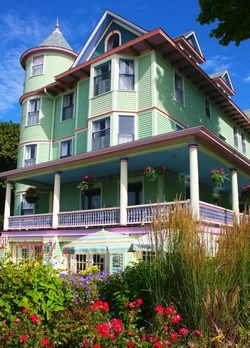Who Owns Mackinac Island? Land, History & Public Access Explained
Introduction
Mackinac Island is one of Michigan’s most popular travel spots. Known for its old-world charm and car-free streets, the island draws thousands each year. Visitors love the beautiful views, horse-drawn carriages, and historic buildings.
But one common question often comes up: Who owns Mackinac Island?
Is it all public land? Can people buy homes here? How much of it can you visit?
This article helps answer these questions. It explains the land ownership, the island’s history, and where the public can go. If you’ve ever wondered how Mackinac Island is owned and shared, keep reading.
A Quick Geographic & Cultural Overview
Mackinac Island sits in Lake Huron. It lies between Michigan’s Upper and Lower Peninsulas. The size of the island is roughly 4 square miles. Although it’s small enough to visit in a single day, it’s rich in culture and history.
There are no cars allowed here. People get around by bike, foot, or horse carriage. This makes the island feel peaceful and different from modern cities.
Other unique facts include:
- About 500 people live here year-round.
- Thousands more visit between May and October.
- It’s known for its fudge, fort, and beautiful shoreline.
The whole island feels like a trip back in time. Streets are quiet. Buildings follow historic styles. Nature plays a big role in daily life.
Who Actually Owns Mackinac Island?
Land on Mackinac Island is owned by a mix of groups. Here’s how it breaks down:
- The State of Michigan owns about 80% of the island. Mackinac Island State Park is in charge of overseeing this property. It includes trails, forests, and historic sites.
- Private Landowners own roughly 15–20%. These are homes, cottages, hotels, and stores. Some of the homes have been in families for many years.
- The City of Mackinac Island owns a small portion too. This includes city buildings, roads, and public services.
- The Federal Government owns historic sites like Fort Mackinac.
This mix of public and private land keeps the island balanced. It’s both protected and lived in. Most of the land is open to visitors, but some areas are private homes. Always be respectful and stay on marked paths.
Historical Background of Ownership
Mackinac Island has a rich and layered history. Before tourists, forts, or fudge shops, Native American tribes lived here. For the Ojibwe and other Anishinaabe, the island was a sacred spot.They believed spirits lived in the rocks and water.
In the 1600s, French explorers arrived. They set up fur trading posts and missions. Later, the British took control during the 1700s. The British built Fort Mackinac in 1780 to protect their hold on the Great Lakes.
Once the American Revolution was over, the island joined the US. The U.S. military took over the fort and used it for many years.
One major change came in 1875. Mackinac Island was designated as America’s second national park, following Yellowstone. The federal government wanted to protect its beauty and history.
In 1895, the island was given to the State of Michigan. That’s when it became Mackinac Island State Park. Since then, the state has taken care of most of the island’s land.
Public Access & What Visitors Can Enjoy
Today, Mackinac Island is open to everyone. The majority of the area is open to the public for exploration. Visitors can enjoy forests, trails, and lake views without needing tickets.
Here are some things you can explore:
- Fort Mackinac – A historic fort with daily cannon and rifle demos.
- Arch Rock – A natural limestone arch over 140 feet above the lake.
- Miles of Trails – Great for biking, hiking, and horse-drawn carriage rides.
- Downtown Shops and Restaurants – Local businesses add charm to the visit.
The island also has over 70 miles of roads and trails. These are mostly within the state park. Maps are easy to find, and most paths are well marked.
It’s important to know some land is private. That includes homes, cottages, and businesses. Always respect “Private Property” signs. Stay on trails and avoid entering residential areas.
Mackinac Island does a great job blending public fun and private life. It feels open and welcoming, yet still cared for by those who call it home.
Living on Mackinac Island
Life on Mackinac Island is very different from life on the mainland. About 500 people live here all year. Many work in tourism, run businesses, or serve in public roles.
Living without cars means a slower pace. People use bikes, horses, or walk everywhere. Winters are quiet and calm. Summers bring crowds, energy, and seasonal workers.
Owning a home here is possible, but not common. Land is limited and often passed down in families. Most homes are historic cottages or Victorian-style houses. Maintenance rules are strict to keep the island’s look and feel.
Year-round residents help maintain the island’s charm and community. In addition to owning stores and preserving history, they work in local government.
Fun Facts About Mackinac’s Land Ownership
Mackinac Island has many unique facts when it comes to property:
- The Grand Hotel is privately owned and over 130 years old.
- Most real estate sales are private or handled by local brokers.
- Homes often stay in families for generations.
- There are no large real estate chains on the island.
Because so much land is protected, not many new homes are built. Most private landowners follow historic preservation rules. That keeps the island’s style true to its past.
Owning land on Mackinac comes with pride and responsibility. It also means living with tourists, rules, and a deep sense of tradition.
Conclusion
A unique combination of public and private land is Mackinac Island. The majority of the island is owned by the State of Michigan through the state park. That gives visitors a chance to enjoy nature, history, and stunning views.
Through their residences, hotels, and businesses, private landowners contribute charm. They help keep the island alive and well cared for.
As a visitor, you can:
- Explore parks and trails
- Visit museums and shops
- Enjoy the island’s beauty—just stay respectful of private space
For a cozy and memorable stay, consider booking at the Inn on Mackinac. Located close to downtown yet peaceful, it offers the perfect mix of comfort and island charm.
Whether you stay for a day or a week, Mackinac offers something special. Its careful mix of history, nature, and hospitality makes it a true Michigan gem.
Category: Mackinac Island


